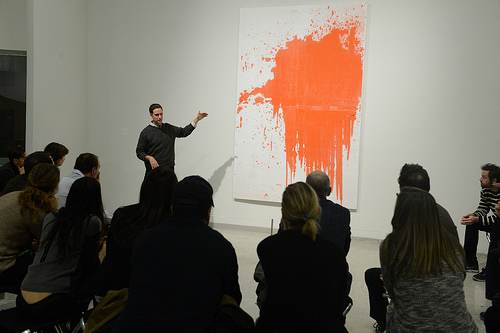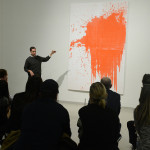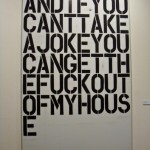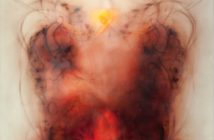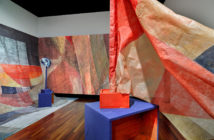While some work bears echoes of the Abstract Expressionists, Wool’s practice seems heavily engrained in printmaking and finds its home in working against a mechanical force. The homage paid to those giants of Modernism is presented in a contained, calculated way that is not in keeping with the aims of the loose, gestural artists who claimed that territory. The mechanical, repetitious elements of print processes, (often hand stencils, screens and rollers) allows Wool a space to explore the friction between that which is machine-made and hand-made. This dilemma seems simple enough to grasp and relevant enough, too, in our current society and culture. It might even seem redundant or obvious, but Wool employs a subtlety in his questioning of the craft as a means to make art that opens up a wider conversation.
There is an inherent tenderness in the formal aspects of the graphic black and white works. That which is human is allowed to be center stage, as we watch Wool try and try to dissect perfection. The use of the grid in many pieces is a tool by which Wool explores subtle differentiations of value, line, and shape. His use of patterning employs the decorative and ornamental as a means of exploring breaks or disruptions in a continuous stream of sameness. Often some of the "accidents" seem planned or pre-orchestrated. The placement of the mistakes is co-opted and taken ownership of. Wool’s interest lies in displaying the rupture of a seemingly structured and airtight pictorial logic. This approach can be viewed in pieces like Untitled (1987), where Wool uses a vine/floral-esque pattern as a template for disruption. This enamel painting on aluminum, which was made with cheap hand rollers, exemplifies the walking of a delicate line between precision and fluidity in mark-making. His variation in density and viscosity of paint, as well as fluctuating value and deviating scale of imagery shows off a deft facility and ownership of the use of the body in making work. The piece is a bleed of patterning, made up of tiny leaf like shapes and vine-y thin lines. The shift comes from the left hand side and middle of the composition, where the pattern becomes stretched out and tilted in vertical strips. This technique is off putting and disorientating to the eye. The discomfort of being asked to see variations of the same pattern is where the magic of Wool’s work takes place. The pictorial shift that happens opens up a moment where we are invited to take notice of and expand our perceived sense of order and logic.
This displacement occurs in the formalist breakdown of his letters as well. Wool’s word pieces were supposedly inspired by an interaction with graffiti from his youth: the visage of freshly made graffiti upon a white truck. One can see how that stark, graphic quality made an impact on him, though Wool’s words don’t embody the looseness of someone painting in the streets, or the finessed rendering of someone like Ed Ruscha. Wool’s work seems to lie somewhere between the gritty, underground aesthetic of the early 80’s New York Punk scene and longstanding folk/craft traditions. It becomes high art when we view it in the museum, but even Wool’s materials (often enamel, rice paper, rubber stamping, aluminum and flashe) gives the work a DIY, homemade feeling. I kept imagining some of these words printed on flimsy white, crinkly paper and hanging in some place like Death by Audio, a small up and coming music venue in Williamsburg, Brooklyn.
Wool’s word pieces are often somewhat cryptic phrases gleaned from pop culture and re-contexualized in his paintings. His dissection of the formal aspects of typography allows us to see double meaning in each piece. At first glance we might take in what the words mean. We might chuckle, as some of it delves into humor, and we might ponder as to the origin of these familiar seeming phrases. The other meaning is found in the breaking up of these letters into shapes and marks. We are asked to view not just the words that make up our collective consciousness, but also the way they literally look on a base level. In this way Wool proposes an idea which might seem counter-intuitive to many. Wool’s work suggests that to pull apart and study the surface of things can be a means by which we find something beyond the thing. I was reminded of Gertrude Stein’s work and how she stripped words of their meaning by placing them in strange relationships with each other. Unlike Stein, the meaning of the words and logical placement of them has resonance, in conjunction with their liminal presence. Apocalypse Now is such a piece. In using the quote from the famous movie ("Sell the house sell the car sell the kids") Wool is able to access the subconscious rumblings of many. The phrase obviously taps into a need for materialism and excess, and a very American search for meaning that is played out in our need for "more more more." Even having kids can seem like one of many aspects on a checklist for the successful person. We begin to ask ourselves what these words really mean, not only literally, but what the shape of these words and our taking in of them could mean in our lives.
Wool’s acknowledgement of the dualistic nature in which we see, in which we read, and take in visual information seemed to open up much within my psyche. I began to apply this lens of dualism to the act of the mistake. Is there a moral implication, even in art making, of right and wrong? And furthermore, what in our culture dictates that morality? I began to see the show as questioning a broader, overarching theme that trickles through and pervades our experience today that is linked to an American upholding of perfectionism and idealism. Like Wool himself, I scoff at this idea, and say "The harder you look, the harder you look."
Christopher Wool closes January 22.

